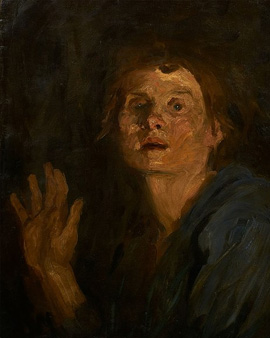


The life and artistic work of Clara Siewert is characterized by a non-simultaneity. While her standards and lifestyle were always rooted in the bourgeois educational elite, her artistic expression found its way into modernity. Growing up in Gdansk, she lived with her sisters the typical life of a higher daughter. Her father had to flee Russia after political conflicts and found a new home in the free city of Danzig. Her mother counted the romantic writer icons Friedrich and August Wilhelm Schlegel among her direct ancestors. Riding lessons were standard as well as the artistic education of the daughters. However, this social requirement was in contradiction to the economic situation of the family. Domineering identity and precarious financial situation were to be the opposites that would shape the sisters' lives. One observer described the sisters' shared apartment in Berlin later as falling out of time. With ancestral portraits and heavy, massive heirlooms as furniture, it stood in contrast to the modern metropolis.
Clara Siewert decided already in her childhood to become a famous painter. Her artistic training in Königsberg and Berlin brought her in contact with artists of the Berlin Secession, in which progressive artists formulated a counter position to the established academic art scene of the Wilhelminian period. After the founding of the Secession in 1898, Siewert became one of the few female artists to gain access to the elite circle. Siewert quickly managed to gain a foothold in the Berlin art scene of the 1890s and found an adequate form of expression in Impressionism. At the turn of the century in Berlin, the Wilhelmine Empire with its antiquated ideas and pictorial worlds met industrial modernism and rising capitalism. A split in which Siewert also recognized himself. In Berlin, she also met Käthe Kollwitz, who in later years repeatedly attempted to promote the artist colleague who had fallen into oblivion and to place her in exhibitions. Both were united in the search for new forms of expression that would reflect the changed reality of the metropolis.
In 1912, Clara Siewert's departure from the Berlin Secession put an abrupt end to her previously successful career. The exact circumstances have not been clarified until today. Her participation in exhibition projects ended and the artist disappeared from the scene. Only in 1936 did she make her last major appearance in a Berlin gallery, but this also remained unsuccessful. The break in her career coincided with her withdrawal into a shared apartment with her two sisters, who were also artistically unsuccessful. The death of her sister, who tried her hand as a writer and had little income, finally plunged Siewert into a depressive phase. Siewert joined the Reich Chamber of Culture after 1933 and died completely impoverished in collapsing Berlin in 1945. 2008 saw an exhibition entitled "Clara Siewert. Between Dream and Reality" led to a rediscovery of the artist of Berlin Impressionism.

The life and artistic work of Clara Siewert is characterized by a non-simultaneity. While her standards and lifestyle were always rooted in the bourgeois educational elite, her artistic expression found its way into modernity. Growing up in Gdansk, she lived with her sisters the typical life of a higher daughter. Her father had to flee Russia after political conflicts and found a new home in the free city of Danzig. Her mother counted the romantic writer icons Friedrich and August Wilhelm Schlegel among her direct ancestors. Riding lessons were standard as well as the artistic education of the daughters. However, this social requirement was in contradiction to the economic situation of the family. Domineering identity and precarious financial situation were to be the opposites that would shape the sisters' lives. One observer described the sisters' shared apartment in Berlin later as falling out of time. With ancestral portraits and heavy, massive heirlooms as furniture, it stood in contrast to the modern metropolis.
Clara Siewert decided already in her childhood to become a famous painter. Her artistic training in Königsberg and Berlin brought her in contact with artists of the Berlin Secession, in which progressive artists formulated a counter position to the established academic art scene of the Wilhelminian period. After the founding of the Secession in 1898, Siewert became one of the few female artists to gain access to the elite circle. Siewert quickly managed to gain a foothold in the Berlin art scene of the 1890s and found an adequate form of expression in Impressionism. At the turn of the century in Berlin, the Wilhelmine Empire with its antiquated ideas and pictorial worlds met industrial modernism and rising capitalism. A split in which Siewert also recognized himself. In Berlin, she also met Käthe Kollwitz, who in later years repeatedly attempted to promote the artist colleague who had fallen into oblivion and to place her in exhibitions. Both were united in the search for new forms of expression that would reflect the changed reality of the metropolis.
In 1912, Clara Siewert's departure from the Berlin Secession put an abrupt end to her previously successful career. The exact circumstances have not been clarified until today. Her participation in exhibition projects ended and the artist disappeared from the scene. Only in 1936 did she make her last major appearance in a Berlin gallery, but this also remained unsuccessful. The break in her career coincided with her withdrawal into a shared apartment with her two sisters, who were also artistically unsuccessful. The death of her sister, who tried her hand as a writer and had little income, finally plunged Siewert into a depressive phase. Siewert joined the Reich Chamber of Culture after 1933 and died completely impoverished in collapsing Berlin in 1945. 2008 saw an exhibition entitled "Clara Siewert. Between Dream and Reality" led to a rediscovery of the artist of Berlin Impressionism.
Page 1 / 1






